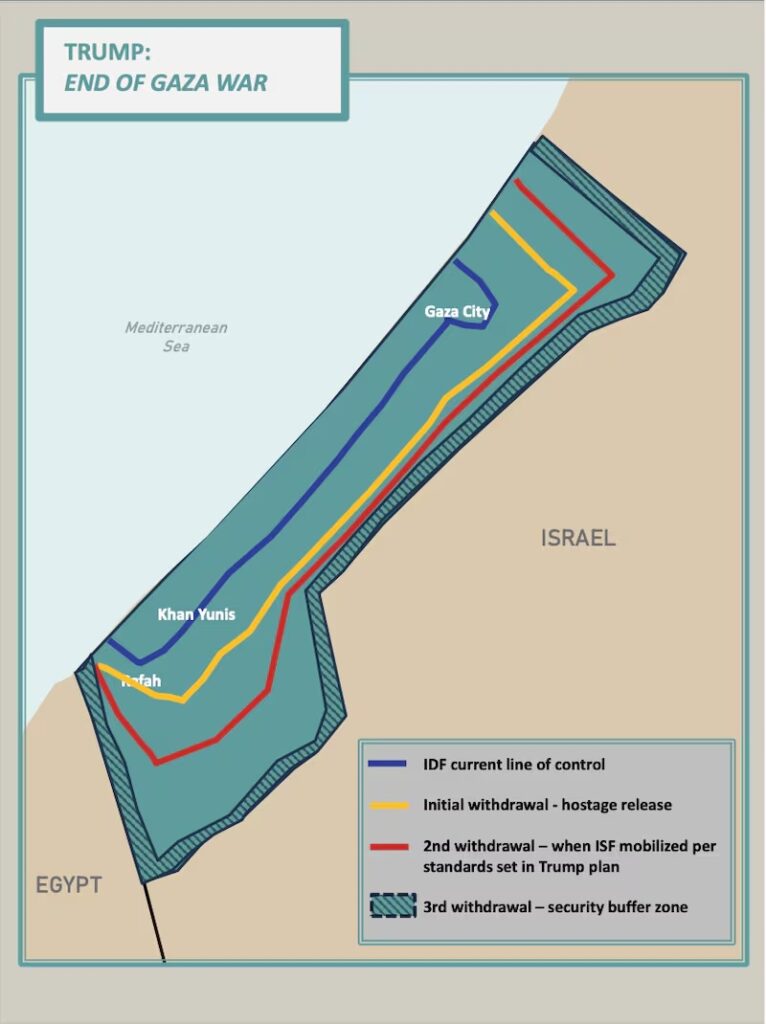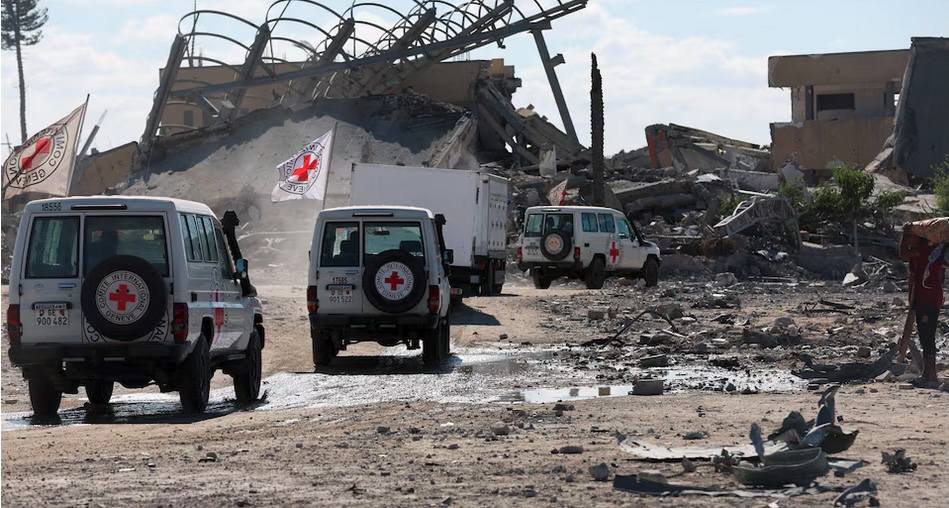On October 10, the devastating bombings and other attacks that the Israeli military has undertaken against Gaza nearly continuously for the past two years finally came a halt. (Or nearly so, see below.) The Israeli military’s massive tanks and bulldozers began to lumber their way out of some– but far from all– of the parts of Gaza they had devastated over those 24 months. Some aid trucks started to roll in. Hundreds of thousands of the Palestinians who’d been forced, under withering Israeli fire, to evacuate south from Gaza City started to trudge back north to their former– very often completely pulverized– homes.

U.S. Pres. Trump was the one who successfully forced the Israeli government to sign onto that ceasefire agreement. (He could, at any moment since his inauguration back in January, have used Washington’s near-complete sway over Israel’s military decisionmaking to force that same outcome… And so, at any point in the preceding 15 months, could his predecessor in the White House. How many thousands of lives and destinies would have been saved?)
On October 13, as the reciprocal captive-exchange portions of the October 10 agreement were completed, Trump organized two large, splashy public events– one in Israel, one in Egypt– at which with his now horribly familiar braggadocio he took his victory laps for the ceasefire.
Vast throngs of people in both Gaza and Israel expressed loud public joy in the deal’s early days. The Gazans were celebrating the cessation of the former, near-constant bombings, the arrival of some aid, and especially the arrival of some hundreds of their loved ones from the prison camps of Israel. The Israelis were celebrating the return of the 20 live captives– all of them, at this stage, actually prisoners of war— whom Hamas and its allies in the resistance released on October 13.
You can read a text version of the six steps/points that the parties agreed to on October 10 if you scroll down on this webpage. (As I noted in this post on Globalities that day, those steps covered only six of the original “20 points” of the plan that Trump unveiled, with much fanfare, at a meeting in the White House September 29, with PM Netanyahu. More on the fate of the “missing 14 points”, below.)
But how durable is the ceasefire that’s now in place, and what are the possible implications of it succeeding or failing?
Already, on October 10 itself, there were some signs that the ceasefire was looking fragile. Just before the Israeli military withdrew back to the “Yellow Line” that day, they set debilitating fires at various locations in/near Gaza City, including at a crucial water-treatment plant on which local residents were deeply reliant. (Which is, of course, a war crime.) And they orchestrated the killing of the sons of two key Hamas leaders.
There have been several reported incidents over the days since then of Israeli military units or some of the local mercenaries who’ve worked with them in Gaza having killed additional Gaza residents. And today, the Israeli government claimed that Hamas had not been fast enough in transferring the bodies of the 28 slain captives/hostages thought to be located somewhere in Gaza– and that it would therefore keep the Rafah crossing closed and cut the number of aid trucks it would allow into Gaza from 600 to 300.
Yesterday, Hamas handed over four bodies. It was reportedly ready to hand over another four today, and four more tomorrow.
The actions and allegations described here pose early, and possibly momentous, tests to the rudimentary mechanism the October 10 agreement established for monitoring compliance with the ceasefire’s terms. Per Article 5 (e) of the agreement, the “two sides” (Israel and Hamas) agreed to establish,
an information-sharing mechanism… through the mediators and the ICRC [the International Committee of the Red Cross], to exchange information and intelligence on any remaining deceased hostages that were not retrieved within the 72 hours or remains of Gazans held by Israel. The mechanism shall ensure that the remains of all the hostages are fully and safely exhumed and released. Hamas shall exert maximum effort to ensure the fulfillment of these commitments as soon as possible.
The “mediators” mentioned there are the United States, Qatar, Egypt, and Turkey. Over the weekend, the U.S. military started deploying a unit of some 200 troops to Israel, to establish a “civil-military coordination center” to “help facilitate the flow of humanitarian aid as well as logistical and security assistance into the territory wracked by two years of war.” By some accounts, Qatar and Turkey would also be sending civilian or military people to help with that task. (I have no information yet on what monitoring may be planned for the Rafah crossing that directly connects Gaza and Egypt. But it’s worth recalling that for many years now, all passage of people and goods through that crossing has anyway been subjected to Israel approval through the always cumbersome “coordination” mechanism.)
Meanwhile, on issues relating to the release of captives’ remains, the role of the ICRC remains key. The ICRC has a long history– including in Gaza– of overseeing the exchange of live and dead captives, in a generally trustworthy way. Today, a spokesman for the normally ultra-discreet ICRC told reporters that it may take considerable time to hand over the remains of hostages and Palestinians who died during the Israel-Hamas war, describing it as a “massive challenge” to locate and extricate these bodies in Gaza’s extensive rubble fields.
But Pres. Trump is not one who’s constrained by either personal norms of discreetness or any regard for the facts. On Truth Social today he thundered, “the job IS NOT DONE. THE DEAD HAVE NOT BEEN RETURNED, AS PROMISED!”
And what, meanwhile, of the other “14 points” in Trump’s original September 29 plan?
It’s worth recalling a couple of things about the relatively speedy welcome (PDF here) that the Hamas leadership gave to that plan, which they did on October 3. First, they made clear– then and during the days of follow-up negotiation that followed– that they remained in close consultation throughout with the other factions that are part of the fighting resistance coalition in Gaza, mainly the Palestinian Islamic Jihad (PIJ) and the PFLP.
Secondly, while they expressed appreciation for the initiative Trump took in issuing the plan, and agreement for the basic formulas regarding captive release and ceasefire that were contained therein, they were then– and remained– notably tight-lipped regarding all the subsequent provisions defined in the plan. And that silence continued through all the rest of the negotiations.
As I noted here last week,
The 6-step plan [that was finally agreed October 10] covers only points 2, 3, 4, 5, 7, and 8 of Trump’s earlier 20-point plan. It notably makes no mention of any effort to “de-radicalize” the population of Gaza, or of the other portions of Trump’s plan that envisaged a colonial-style administration being installed in Gaza under the viceroy-ship of widely discredited former UK prime minister Tony Blair.
The Hamas leaders also made no comment on the stipulation (#13) that there would be a wide-ranging demilitarization of Gaza– beyond noting their longheld policy that in the context of the establishment of an independent state in Gaza or the West Bank, they would decommission their fighting forces and/or fold them into that state’s military.
Meantime, from almost the moment that the Israeli military started withdrawing from portions of Gaza, the civilian structures with which Hamas and its allies have ruled Gaza since 2007– including the police structures– were resuming the governance role at ground level that they had played during the 6-week ceasefire of last January-February… and which the Israeli military had attacked so viciously when they bust violently out of that earlier ceasefire, from March 2 on.
For his part, Pres. Trump has anyway seemed to be stepping back from some key portions of the 20-point plan he presented September 29. Most notably, #19, which stated that over time and as certain conditions are met, “the conditions may finally be in place for a credible pathway to Palestinian self-determination and statehood, which we recognise as the aspiration of the Palestinian people.” Yesterday, however, he backtracked significantly, saying that he could not decide if there should be a two-state or a one-state solution.
And at #9, the plan had specified that the temporary governance structure envisaged for Gaza would operate under the, “oversight and supervision [of] a new international transitional body, the ‘Board of Peace,’ which will be headed and chaired by President Donald J. Trump, with other members… including Former Prime Minister Tony Blair.” But by the time Trump got to the big Sharm el-Sheikh confab yesterday, there was no explicit mention of Blair having a role. That’s a relief.
(Meantime, Blair, a serial grifter, was being criticized in the British media for having accepted a week-long, all-expenses-paid vacation for himself and his whole family, to Sharm el-Sheikh, just last December…)
Clearly, many weighty (and tough) negotiations will be required if the people of Gaza are to get anywhere close to the stabilization and possibility for reconstruction and rights restoration that they so desperately need. The role of international actors, at many different levels, will be crucial. This includes, in the first rank, the three “co-mediating” governments that worked alongside Pres. Trump to nail down the 6-point plan. But not just those governments! The peoples of those three countries– Egypt, Turkey, Qatar– will also need to be very active in keeping up the pressure on their government to ensure timely and complete Israeli-U.S. compliance.
(To be honest, I’m not sure if there is such a political force as “the people” of Qatar. But still, by virtue of the size of its bank accounts, the state of Qatar does play a very central role.)
Beyond those three co-mediating parties, the governments and peoples of all the other world’s countries will also have a big role to play.
Do the European governments, or the other Arab and Muslim governments, think that just the implementation of the 6-point plan– if, indeed, that even happens– will be enough for the people of Gaza, and that if that happens they can all dial back on the teeny-weeny baby steps some of them have started to take to start to hold Israel accountable for its atrocities… so now it can just be business as usual for Israel?
Let’s hope not.
How about the United Nations? The chronically timid and pro-American António Guterres made a tiny appearance at the Sharm el-Sheikh meeting. But what has he done over the past 24 months to try to uphold international law?
It seems that the UN’s humanitarian agencies will be playing a big role in the “surge” of humanitarian aid into Gaza that is envisaged in the 6-point plan. There have been many mentions of this surge now involving the passage into Gaza of 600 aid trucks a day, which seems like a minimum given the intense nature of the destruction Israel caused there and the imminent arrival of winter. But when the Israelis brusquely say they will cut that number in half, or if– God forbid!– they resume their practice of targeting humanitarian-aid workers, what will we hear from Guterres or from any of the UN’s leading governments?
To be frank, I am still fairly pessimistic about the prospects of even the 6-point plan working out as it was agreed. The main sources of any hope I have are twofold: First, the prospect that the existing, global citizens’ mobilization in support of the Palestinian rights can be sustained and further strengthened. (That is basically up to all of us.) And second, that a combination of this grassroots pressure with Washington’s continued and cruel scofflawry on a whole range of other pressing global issues— climate change! trade! so many other issues!– will mean that the ability of the Washington-Tel-Aviv axis to continue to defy world opinion over Gaza becomes speedily and substantially reduced.
We will see…


